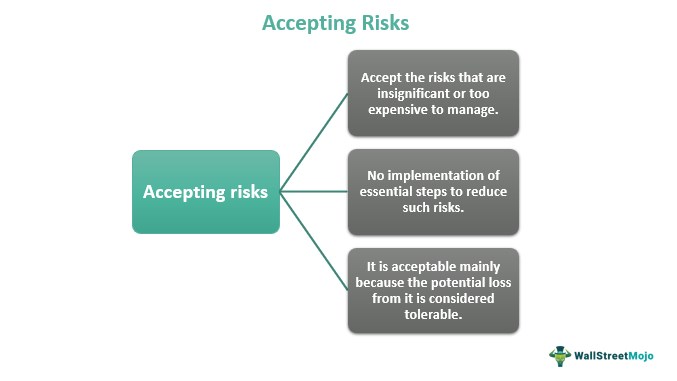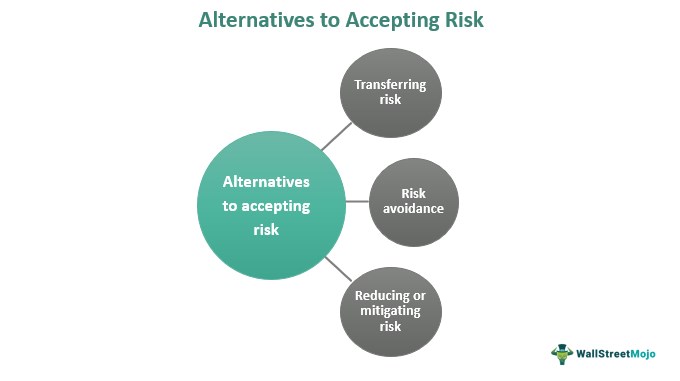Table Of Contents
Accepting Risk Definition
Risk acceptance is the act of making a deliberate choice to accept the chances and consequences of a specific risk. The level of acceptance is primarily influenced by risk type and top management's degree of risk appetite.

Positive results may come from accepting tolerable levels of risk since some risk will always be a part of conducting business. Moreover, accepting risks helps an entity or individual prepare for the worst-case scenarios and safety nets and smooth the downfall. Hence, importance should be given to identification, quantification, prioritization, and strategic risk management.
Table of contents
- Risk acceptance is the deliberate decision to accept the probabilities and effects of a certain risk. It is also known as risk acceptance or risk retention.
- It explains accepting the risks that are insignificant or too expensive to manage. Various methods, including cost-benefit analysis and discursive strategies, can support the decision-making process for risk acceptance.
- The most common risks include credit risk, project failures, market unpredictability, accidents, legal liability, natural disasters, and threats from competitors.
- Alternative to the accepting strategy includes risk transferring, avoidance, and mitigation.
Accepting Risk Explained
Risk acceptance is a managerial decision not to make any significant effort to lessen the effects of a specific risk identified. In more detail, it refers to the procedure by which an entity accepts a particular risk. When a risk is accepted, the person or entity accepting the risk acknowledges that there is a chance of loss. The practice of "embracing risk" is a means of risk retention and management. It could be because it is a prerequisite for achieving a corporate, organizational, or community goal or because it is a part of the business model.
Accepting risks is not a technique for mitigating risk because accepting a risk does not lessen its impact. However, accepting risk is a valid element in a risk management strategy. Companies may select risk acceptance in some circumstances for a variety of reasons. The most common rationale is that the price of alternative risk management strategies, like risk avoidance or risk limitation, may be higher than the price of the risk itself. For example, there is no advantage to investing $500,000 to mitigate a $50,000 risk. Most businesses accept a risk rather than invest time or money in its mitigation when the cost surpasses the gain.
Businesses should be able to balance the expenses of risk management with the costs associated with the risk when managing risks since a successful business relies on better risk management practices. The most common risks include credit risk, project failures, market unpredictability, accidents, legal liability, natural disasters, and threats from competitors. A company must first identify the risk, evaluate their seriousness, and then prioritize them to keep track of them, lessen their consequences, and maintain control over the risk.
How To Avoid?
Various methods, including cost-benefit analysis and discursive strategies, can support the decision-making process for risk acceptance. Later the decision alternatives are ranked according to how useful they are projected to be, in other words, based on their utility. The decision alternative that maximizes expected utility is the best one to choose. Similarly, cost-benefit studies can be used to determine the economically optimal and effective options.
Examples
Let's look into some of the examples for a better understanding of the concept:
Example #1
A construction company has a tight deadline to be met. The keys must be transferred to the owners soon, but unfortunately, there is a pandemic outbreak, and the government ordered a complete lockdown. In the initial stages, nobody knew what was happening. Although the deadlines are approaching, the company decided to halt construction because if they continued, it would put them in trouble with the government and contribute to the intensification of the pandemic.
It is a type of risk acceptance since the company identified and accepted the risk of losing or making their clients unhappy. The owners may be disappointed with it and may even lose their business.
Example #2
Dan is a store owner. He wants to buy glass products worth $10,000. However, he is afraid of glass breaking in transit. So, he does research and finds that protective coverings that prevent the glass from breaking will cost him double the amount he invests in these products. Since this will be a one-time purchase, he decides not to invest in the protective covering. He accepts that the transportation involves the risk of losing his $10,000, but it is acceptable as the cost of avoiding this risk would have been double.
Pros And Cons
Pros of risk acceptance are:
- Facing uncertainties: Risk analysis gives a good idea of the possible damage involved, and one can prepare accordingly. It helps entities and individuals be mentally prepared to face situations and act accordingly.
- Aids in building confidence to act in adverse situations: Analysis in advance can prompt people and push them to plan and prepare safety nets. Individuals will be better able to handle market risk and market volatility once they have some safety net. A portion of the pressure will be reduced by taking safeguards. People feel more at peace if they are confident that even the worst-case scenario is something they can manage.
Cons of risk acceptance are:
- Risks are unavoidable: Almost all events have some amount of risk involved. There is almost nothing that is entirely risk-free. Every business plan and every investment opportunity consists of some level of risk. It is up to the risk taker to decide whether the risk is worthwhile in light of the potential rewards.
Alternatives To Accepting Risk

A few alternatives to accepting risks are:
- Transferring risk: One of the best strategies is to shift the risk because it is still possible. The transfer of risk (risk transfer) is best portrayed in the insurance model. For example, a homeowner can transfer the risk affecting their home and assets using homeowner's insurance.
- Risk avoidance: Eliminating any behavior that can result in a loss is a crucial part of risk avoidance. The risks most likely to hurt a plan or business should be avoided. Managers can prevent and reduce risk by implementing policies, controls, educational programs, and technological solutions. For example, a comprehensive risk analysis should be carried out before beginning a new project. Avoiding the risk (and the project) may be the best action if the risk analysis reveals serious or excessive problems that cannot be quickly reduced.
- Reducing or mitigating risk: Risk reduction refers to bringing risk down to a manageable level. Minimizing the effects of a risk to handle is part of risk mitigation. The aim here is to reduce the impact of risk so that when problems emerge, they will be simpler to resolve. Risk reduction should only ever be used as a last option. It's crucial to set limits on the consequences when the threat has already materialized, or the likelihood is exceedingly high. Such a strategy aids companies in preparing for the worst-case scenario. The best strategy for achieving this objective is hedging. Investors use this action when they notice price fluctuations that do not work to their advantage.
Frequently Asked Questions (FAQs)
Generally, avoidable risks are avoided, and other risks are reduced to the maximum level. However, certain risks are accepted, and no significant efforts are made to lessen them because they are categorized as risks that cannot be avoided using suitable measures or the benefit produced from mitigating such risks is too insignificant. Hence such risks are accepted.
Risk acceptance is when a corporation decides to take no significant action to minimize, limit, or transfer the risk, while the goal of risk avoidance is to eliminate the risk through planned events. Acceptance typically has a meager cost (or zero, but it may be costly when a disruption occurs).
Risk acceptance or accepting risk is also known as risk retention. It involves the decision to face the risk instead of altogether avoiding it.
Recommended Articles
This has been a guide to Accepting Risks and its definition. Here, we explain it with its examples, pros, cons, and alternatives. You may also find some useful articles here -
